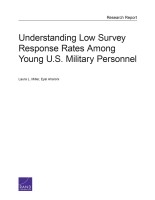| 来源类型 | Research Reports
|
| 规范类型 | 报告
|
| ISBN | 9780833090171
|
| 来源ID | RR-881-AF
|
| Understanding Low Survey Response Rates Among Young U.S. Military Personnel |
| Laura L. Miller; Eyal Aharoni
|
| 发表日期 | 2015
|
| 出版年 | 2015
|
| 页码 | 76
|
| 语种 | 英语
|
| 结论 |
The Low Response Pattern Appears Across Several U.S. Department of Defense Surveys- Lower response rates for younger and more-junior members appear across several online surveys despite differences in survey topics, survey sponsors, sampling strategies, recruitment methods, and survey administration.
- The Air Force is already attempting to reduce the number of surveys it administers and limit their overlap.
Low Response Does Not Necessarily Yield Biased Results- Survey administrators commonly aim to reduce the risk of nonresponse bias by working to increase response rates, but higher response rates do not rule out nonresponse bias. Extra recruiting measures might succeed only in engaging more participants with similar experiences and views. Studies have found similar or statistically identical findings between surveys with higher and lower response rates. No minimum response rate has ever been established as a scientific threshold for minimizing nonresponse bias.
|
| 摘要 |
- The military should seek ways to better understand how well its surveys are capturing a representative sample of the chosen population.
- The military should undertake additional efforts to identify factors potentially contributing to lack of survey participation. This way, strategies designed to address it actually target the source of the problem rather than increase response among the types of people already well represented in the survey.
- Survey analysts should explore whether younger members' noncompletion results from not having begun a survey at all or from beginning it but dropping out early.
- The military should focus efforts to increase response rates on strategies that could benefit the force in other ways, such as ensuring that junior enlisted airmen have routine access to their military email accounts and that their contact information on file is accurate.
- The military should test for nonresponse bias in online surveys.
- The military should not invest significant resources in efforts solely to increase response rates without first testing whether there is any value in doing so.
- Surveys should become mobile-friendly, a shift that will have implications for layout and survey length.
|
| 主题 | Enlisted Personnel
; Military Recruitment
; Organizational Leadership
; Survey Research Methodology
; United States Air Force
; United States Department of Defense
|
| URL | https://www.rand.org/pubs/research_reports/RR881.html
|
| 来源智库 | RAND Corporation (United States)
|
| 资源类型 | 智库出版物
|
| 条目标识符 | http://119.78.100.153/handle/2XGU8XDN/108137
|
推荐引用方式
GB/T 7714 |
Laura L. Miller,Eyal Aharoni. Understanding Low Survey Response Rates Among Young U.S. Military Personnel. 2015.
|
|
文件名:
|
x1509993248798.jpg
|
|
格式:
|
JPEG
|

|
文件名:
|
RAND_RR881.pdf
|
|
格式:
|
Adobe PDF
|
除非特别说明,本系统中所有内容都受版权保护,并保留所有权利。